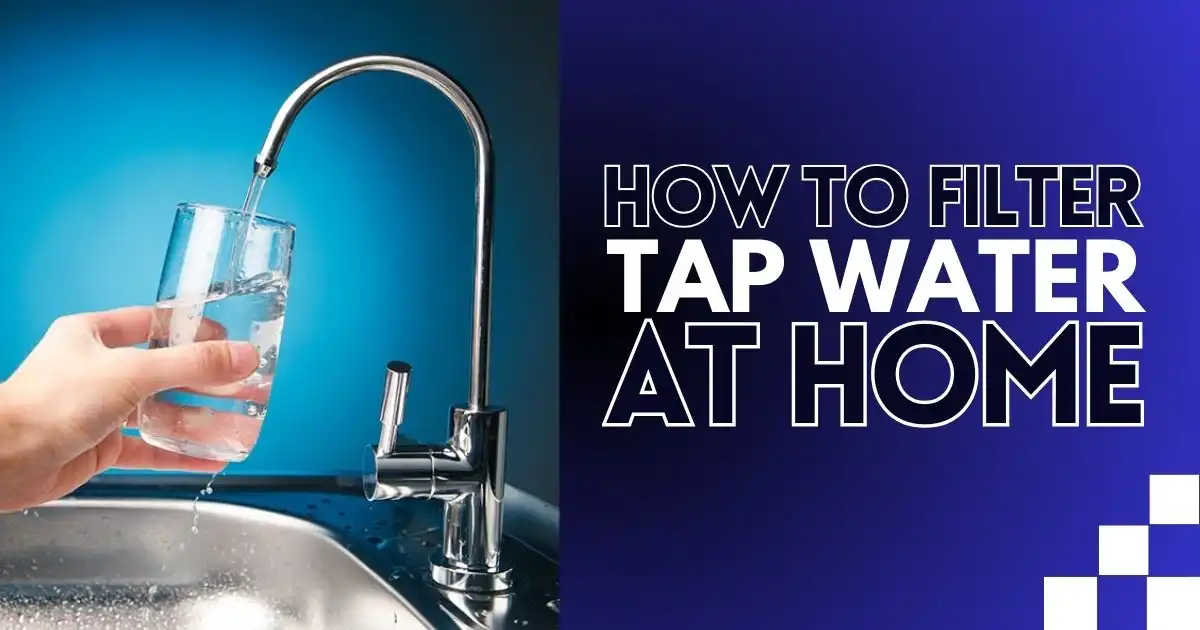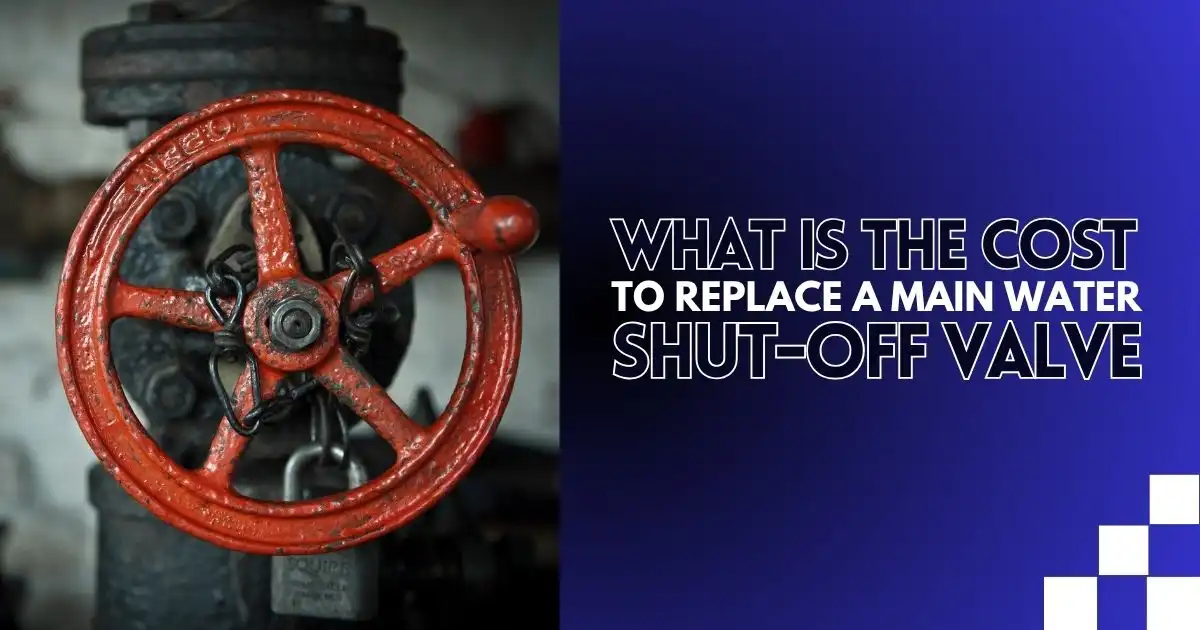You woke up to the sound of rushing water in your Las Vegas home. Your heart races as you step out of bed, only to find yourself ankle-deep in a murky flood. Panic sets in as you realize your cherished possessions, family photos, and carefully curated furniture are all at risk.
In a city known for its desert climate, the last thing you expected was a flood. Yet here you are, facing a homeowner’s worst nightmare. The emotional and financial toll looms large, leaving you paralyzed with one burning question: How do you salvage what’s left before it’s too late? Fast action helps limit the damage and protect your safety.
What To Do Before a Flood in Las Vegas?
Floods can happen unexpectedly, causing severe damage to homes and belongings. The best way to protect yourself is to prepare in advance. Here’s what you need to do:
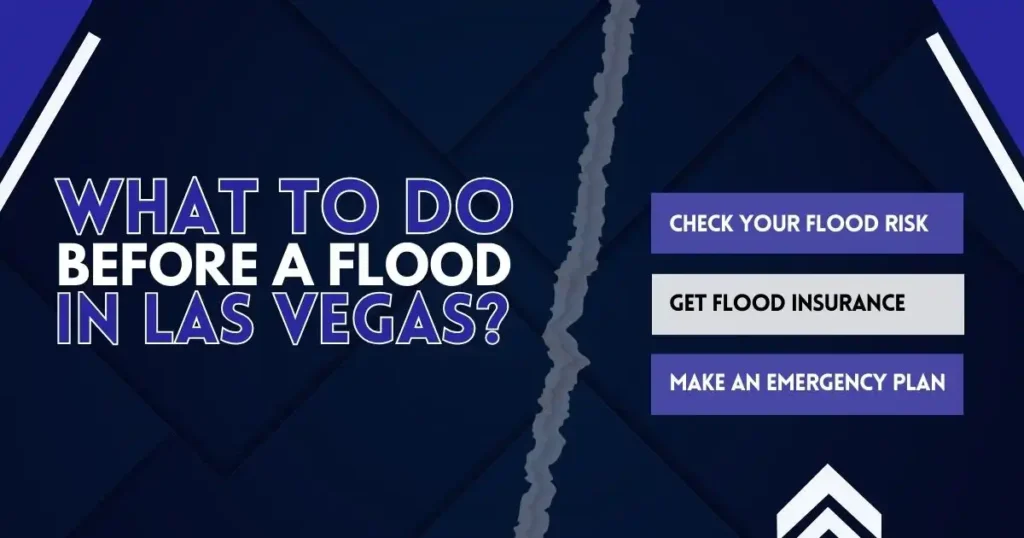
1. Check Your Flood Risk
Start by checking if your home is in a flood zone using the FloodView Advanced tool from the Clark County Regional Flood Control District. You might not realize your home is at risk, even if you live outside a high-risk area. Being aware of flood safety tips ensures you take proactive measures to reduce risks.
2. Get Flood Insurance
Your standard homeowners’ insurance won’t cover flood damage. The National Flood Insurance Program (NFIP), backed by FEMA, offers coverage of up to $250,000 for your home and $100,000 for your belongings. Since even an inch of water can cause $25,000 in damage, having flood insurance is a smart move. Proper coverage is one of the best safety precautions for floods to protect your financial security.
3. Make an Emergency Plan
Preparing for a flood starts with having a clear evacuation plan and a reliable family communication strategy. According to FEMA, nearly 40% of small businesses never reopen after a disaster, highlighting the importance of planning ahead.
The CDC recommends assembling an emergency kit with essentials such as bottled water (one gallon per person per day for at least three days), non-perishable food, necessary medications, and first aid supplies. Additionally, keep important documents like identification, insurance papers, and medical records in a waterproof container. Flash flood emergency preparedness also includes having flashlights with extra batteries, a battery-powered radio, and cash are also critical in case of power outages.
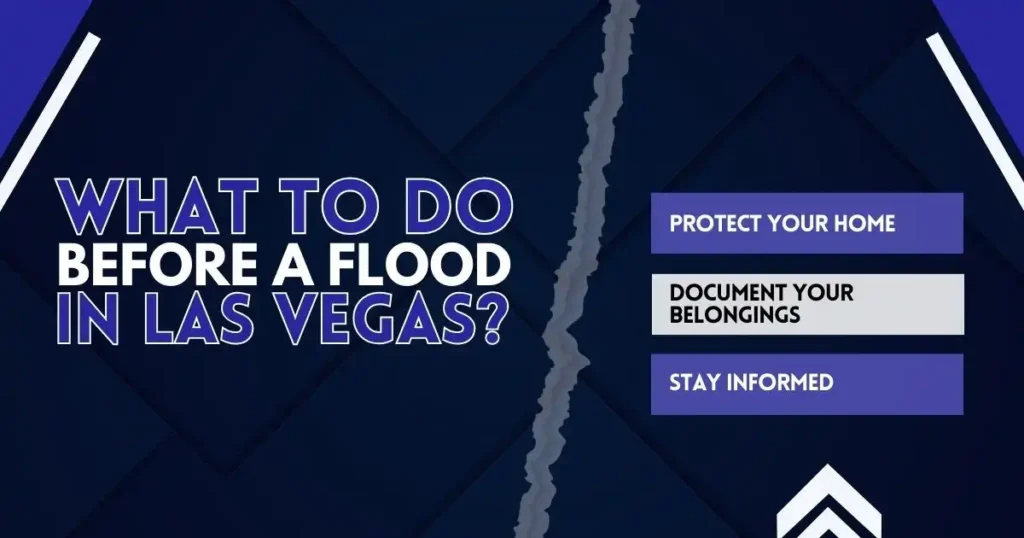
4. Protect Your Home
Taking preventive measures can significantly reduce flood damage and save thousands in repair costs. The National Flood Insurance Program (NFIP) reports that just one inch of floodwater can cause up to $25,000 in damage. To protect your home, consider raising utilities such as furnaces, water heaters, and electrical panels above potential flood levels.
Installing check valves in sewer traps can prevent dangerous backflow, reducing the risk of contaminated water entering your home. Additionally, sealing basements with waterproofing compounds and ensuring proper drainage around your home can help keep floodwaters out. If you live in a high-risk area, installing flash flood safety barriers or sump pumps may provide extra protection.
5. Document Your Belongings
Keeping a record of your possessions can make the insurance claims process smoother and ensure you receive fair compensation if a flood damages your home. The prevention of flood damage starts with proactive planning, and documenting valuables is a key step in securing your financial recovery.
The Insurance Information Institute (III) advises homeowners to take photos or videos of valuables, including furniture, electronics, and important documents, before disaster strikes. Store this information in a secure, cloud-based service or on a flash drive kept in a waterproof container. A detailed home inventory can also help speed up the recovery process, as it provides proof of ownership when filing a claim.
6. Stay Informed
The National Weather Service (NWS) highlights that, on average, flooding claims the lives of 95 people each year in the United States. They also note that more than half of all flood-related deaths are due to individuals attempting to drive through floodwaters. Flash flood emergency situations require staying alert and acting quickly to avoid life-threatening conditions.
Consider using apps like FEMA’s mobile app or NOAA Weather Radio for real-time updates. Knowing the difference between a flood watch (conditions are possible) and a flood warning (immediate danger) can help you take appropriate precautions before it’s too late.
What to Do During a Flood in Las Vegas?

Floods are dangerous and unpredictable, so knowing what to do can help protect you and your family. Following safety tips for floods is essential in both evacuation and stay-at-home situations. Here’s what you should do during a flood:
1. Evacuate Immediately if Ordered
If officials tell you to leave, do so right away. Follow designated evacuation routes and never drive through flooded roads. Just six inches of moving water can knock you down, and one foot can sweep away a vehicle.
2. Move to Higher Ground if Staying Put
If you cannot leave, move to the highest level of your home. Turn off gas and electricity if it’s safe, but never walk through water to do so—it may be electrified or contaminated. Flash flood safety measures include staying on elevated ground and avoiding low-lying areas where water rises rapidly.
3. Avoid Contact with Floodwater
Floodwater can contain sewage, chemicals, and other harmful substances. Avoid touching or wading through it to prevent health risks.
4. Stay Updated and Signal for Help if Needed
Keep listening to emergency alerts on the radio or your phone. If you’re trapped, wave a light or cloth from a window or rooftop to signal for help.
5. Avoid Open Flames
The Red Cross warns against using candles or open flames after a flood, as gas leaks can create a fire hazard. Use flashlights or battery-powered lights instead.
What to Do After a Flood in Las Vegas?
Returning home after a flood can be overwhelming, but taking the right steps can help you stay safe and speed up recovery. Before re-entering your home, check for hazards, document damages, and start the cleanup process carefully.
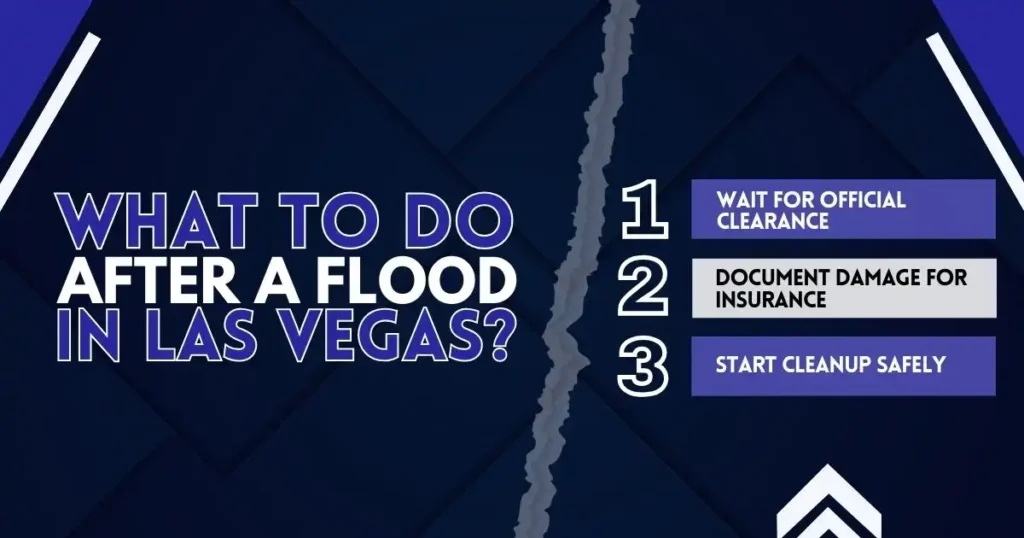
1. Wait for Official Clearance
Do not return home until local authorities confirm it is safe. Floods can compromise structural integrity and introduce dangers like gas leaks and electrical hazards. For instance, the 1999 Las Vegas flood resulted in two fatalities and caused $20.5 million in public property damage, highlighting the importance of understanding flood safety tips before re-entering your home can prevent serious injuries or further damage.
2. Document Damage for Insurance
Before beginning cleanup, take clear photos and videos of all damage to your property and belongings. Contact your insurance company promptly to initiate the claims process. In Nevada, typical homeowners’ insurance policies do not cover flood damage, so it’s necessary to have separate flood insurance. The Nevada Division of Insurance advises contacting your insurance agent immediately after a flood to file a claim.
3. Start Cleanup Safely 2
Remove standing water using pumps or wet vacuums, and open windows and doors to improve ventilation and aid in drying out your home. Wear protective gear such as gloves and masks to shield yourself from mold and bacteria.
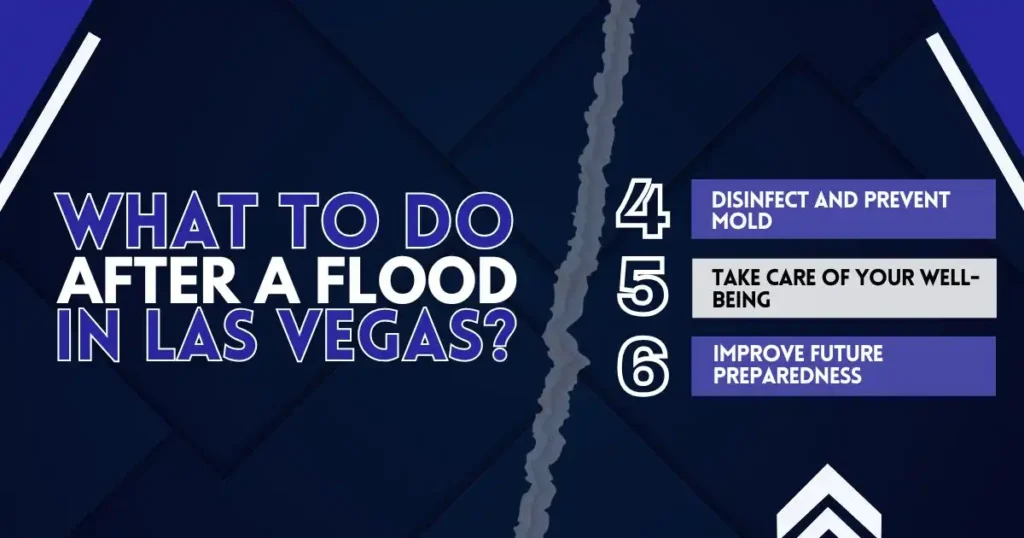
4. Disinfect and Prevent Mold
Thoroughly clean and disinfect all surfaces to prevent mold and bacterial growth. Mold can develop within 24 to 48 hours after flooding, posing health risks. If the damage is extensive, consider hiring professional restoration services for proper water extraction and mold remediation.
5. Take Care of Your Well-Being
Recovering from a flood can be emotionally taxing. Seek support from friends, family, or professional counselors if needed. Local organizations and community groups in Las Vegas often provide resources and assistance to those affected by flooding. Remember, it’s normal to feel a range of emotions during the recovery process, and reaching out for help is a sign of strength.
6. Improve Future Preparedness
After recovery, evaluate the effectiveness of your emergency plan and identify areas for improvement. Consider implementing flash flood safety tips, such as elevating utilities or installing flood barriers. In Las Vegas, approximately 5.6% of properties are at risk of flooding over the next 30 years. Taking proactive steps now can mitigate future risks and enhance your home’s resilience against potential flooding.
Rise Above the Flood
Floods can turn your life upside down in an instant. They don’t just damage your home—they disrupt your sense of safety and leave you grappling with overwhelming emotions. In Las Vegas, where floods often feel like an unlikely threat, the devastation can catch homeowners completely off guard. But this isn’t just about protecting your property; it’s about safeguarding the memories, comfort, and security that make your house a home.
That’s why preparation is key. Taking proactive steps now can help minimize flood risks and keep your home protected. Vegas Plumbing Pros offers expert services to reinforce your plumbing, improve drainage, and install preventive measures to reduce flood damage. Don’t wait for the next storm—contact us today and ensure your home is flood-ready.
FAQs
What to do if your area is flooded?
If authorities tell you to evacuate, do so right away. Knowing what to do during a flood can make all the difference in staying safe. Never drive around barricades—they are there to guide traffic safely out of flooded areas. If you are sick and need medical help, contact your healthcare provider as soon as possible.
What are the safety tips for flooding?
Understanding how to stay safe during a flood is a must. Choose a safe place on higher ground that you can reach quickly and move there before flooding starts. If you live in an area prone to river floods, be aware of the risk. Review your evacuation plan so you can leave immediately if officials tell you to evacuate.
How to protect yourself from floods?
When facing rising waters, knowing how to stay safe in a flood can protect both you and your property. Stay calm and avoid believing rumors. Do not panic, and focus on staying safe. Never enter floodwaters, and keep children away from them. Raise furniture and appliances on beds or tables to protect them. Keep animals in secure shelters. Store harvested crops away from open fields.
What are the actions to be taken after flooding incidents?
Do not go into a flood-damaged home or building until authorities say it is safe. If you must enter, be very careful. Knowing what to do during a flood is important, but staying cautious after the water recedes is just as critical. Floodwater can weaken floors, making them collapse, and ceilings may fall. Before going inside, ensure the electrical system is completely turned off to avoid danger.

